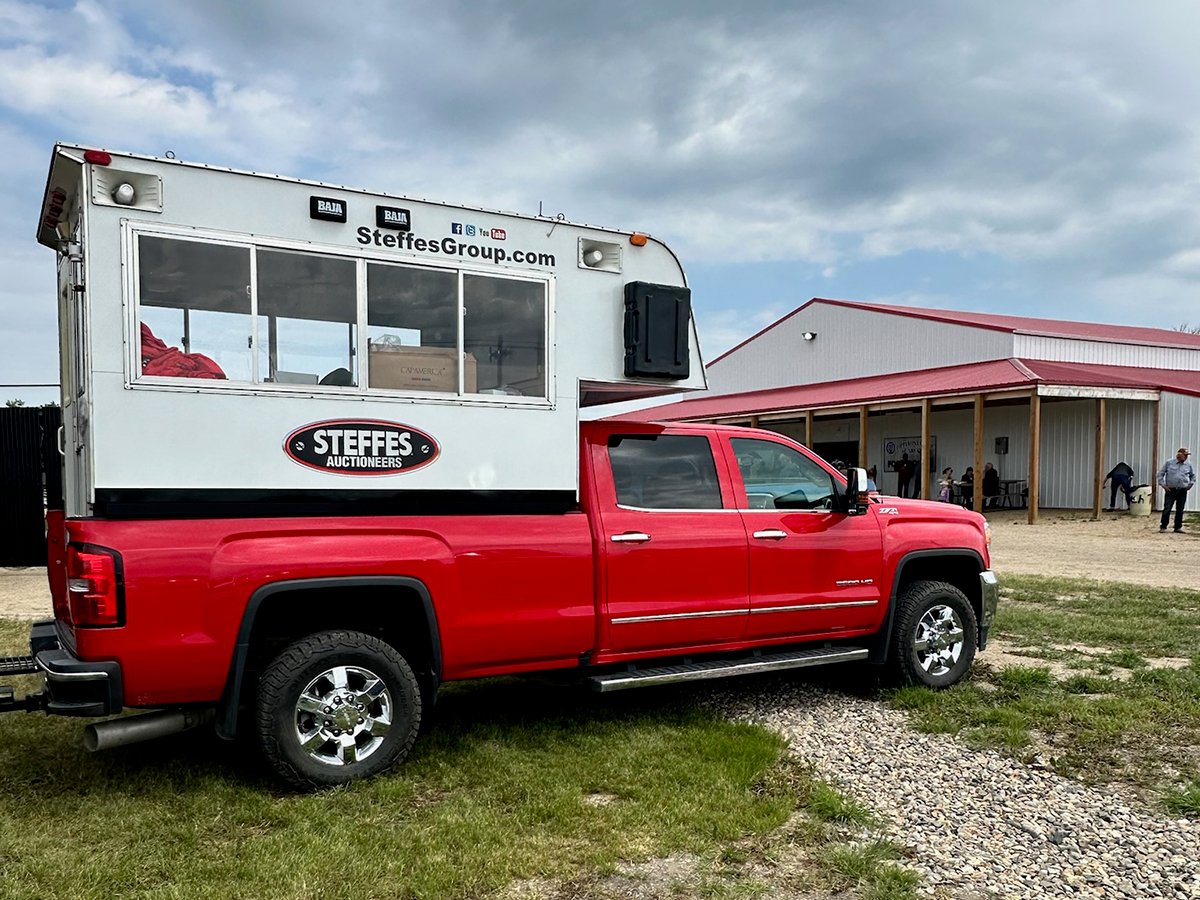I’ve had inquiries asking how the lady who had trouble with the zipper in her dress, (July 3, 2008 issue) got her dress off. She tells me she was able to pull the zipper down inch by inch as she pulled the dress up and over her head inch by inch. She didn’t have to go out into the street for help. Now you know the rest of the story.
Another update is to report that a new house is being built at our farm, to replace the one burned last December. All the remains of the burned house were removed in spring and a new start made.
Read Also

Farm auctions evolve with the times
Times have changed. The number of live, on-farm auctions is seeing a drastic decline in recent years. Today’s younger farmers may actually never experience going to one.
Walls are up, a roof on and windows and doors in. Tradespeople are coming and going doing the plumbing, electrical work, brickwork and heating. Bob, our son, and his wife, Pam, and their children are thankful to the tradespeople for working them into their busy schedules because most were booked up for the summer before the fire.
Those of you who have experienced a fire know the huge amount of work it creates. I couldn’t have imagined how difficult it would be to clean up the site in the cold of winter, to sort, clean, discard, list and relist, make new house plans and to start shopping for everything all over again.
Recipe request:
Dear TEAM: When the paper arrives, I read your column first. The recipes are great. I am looking for a recipe for rhubarb-saskatoon pie that uses a lemon pie mix as thickening. It can be put in sealers and used during the winter. I had this recipe but have mislaid it. – e-mail from M.W.
Dear M.W.: I’ve exhausted my search for your recipe. Would any of our readers have the recipe requested?
Shake and Bake pork chops
An easy meat dish to serve the harvesters.
1/2 cup sugar 125 mL
2 tablespoons flour 30 mL
1/4 teaspoon cinnamon 1 mL
1/8 teaspoon nutmeg 0.5 mL
4 cups sliced apples 1 L
8 lean pork chops
pork Shake & Bake
Combine sugar, flour, cinnamon and nutmeg. Mix with the sliced apples. Spoon into a greased 9 x 13 inch (22 x 33 cm) baking pan. Coat chops with pork Shake & Bake. Place on top of the apples. Bake uncovered at 375 F (190 C) for 45–50 minutes.
Lemon cream pie
In our area the fowl suppers are about to begin. It wouldn’t be fall without these delicious community dinners. Pie is usually served and this tasty lemon cream pie might be something you would like to take to a fall supper. A friend gave the recipe to me.
1 cup sugar 250 mL
3½ tablespoons 53 mL
cornstarch
1 tablespoon grated 5 mL
lemon rind
½ cup fresh lemon juice 125 mL
3 egg yolks, slightly beaten
1 cup milk 250 mL
¼ cup butter 60 mL
1 cup sour cream 250 mL
1 baked 9 inch (22 cm) pie shell
Combine the sugar, cornstarch, lemon rind, lemon juice, egg yolks and milk in a heavy saucepan. Cook with medium heat until thick and there is no taste of raw starch. Remove from heat. Stir in butter and sour cream. Cool. Serve with a dollop of whipped cream or whipped topping.
Answers about listeria
There has been a lot of news recently about listeria. The following information prepared by the Canadian Food Inspection Agency may answer some of your questions.
What is listeriosis?
It is a food-borne illness that occurs when a person consumes food contaminated with the bacterium listeria monocytogenes. This bacterium is often found in the environment, particularly in soil, vegetation, animal feed and in human and animal feces. Although food contaminated with listeria monocytogenes may not look or smell spoiled, consumption of it may lead to food poisoning.
What are the symptoms?
Symptoms may include vomiting, nausea, cramps, diarrhea, severe headache, constipation and persistent fever. Symptoms usually appear within two to 30 days, but may be up to 70 days after consuming contaminated food.
Those at highest risk of listeriosis are pregnant women, newborns, the elderly and people with weakened immune systems. If you get any symptoms, contact your doctor. Antibiotics are often an important part of treatment.
Does it affect pregnancy?
Infected pregnant women may experience only a mild, flu-like illness, but a woman who develops listeriosis during the first three months of pregnancy may miscarry. If she develops listeriosis later in the pregnancy, her baby may be stillborn or acutely ill.
Is there a risk of transferring the bacteria in breast milk?
It is possible but unlikely. However, there is a risk of transferring the bacteria to a newborn from hands that have handled contaminated meat products.
How does listeria spread?
By contact with an infected product or surface, such as hands or countertops, during food preparation. Unlike most other harmful bacteria, it can grow slowly on foods stored in a refrigerator.
Thorough hand washing with soap kills the bacteria and makes spreading it unlikely.
How can I protect my family?
First, carefully review the Maple Leaf consumer foods list of affected products and additional recalled products available on the Canadian Food Inspection Agency website, www.inspection.gc.ca. Second, ensure you do not consume any Maple Leaf products with the code 97B found near the best-before date on the package. If you are unable to find a code and are in doubt whether the product has been recalled, throw it out.
CFIA and public health units across Canada are verifying that all affected product is removed from high-risk institutions such as hospitals, nursing homes and day cares and all retail stores are checked through a normal verification process.
Rather than throw recalled meat away, can I feed it to my pet?
Not unless it is cooked. Otherwise, the bacteria may multiply in your pet and be shed in greater numbers in its feces. Both adults and children could then be exposed from handling the pet. Listeria can cause illness in dogs, but this is rare.
Can I receive compensation for recalled meat products that I purchased?
All questions regarding compensation should be forwarded to the Maple Leaf Foods consumer affairs hotline at 800-568-5801.
Prevention
Read and follow all package labels and instructions of food preparation and storage.
After handling foods in the kitchen, especially raw food such as meat and fish, thoroughly clean and sanitize all surfaces, knives and utensils used for food preparation with a kitchen sanitizer or use a bleach solution (five mL/one teaspoon household bleach to 750 mL/three cups of water), and rinse with water.
Thoroughly clean fruits and vegetables before you eat them.
Refrigerate or freeze perishable food, prepared food and leftovers within two hours.
Defrost food in the refrigerator, in cold water, or in the microwave, but never at room temperature. Keep leftovers for a maximum of four days and reheat them to an internal temperature of 74 C (165 F) before eating them.
Check the temperature in your refrigerator using a thermometer to make sure it is at 4 C (40 F) or below. As the storage temperature increases, so does the growth of listeria in foods. The higher the number of bacteria in foods, the greater is the risk of getting sick. Frequently wash and disinfect the refrigerator.
Alma Copeland is a home economist from Elrose, Sask., and one of four columnists comprising Team Resources. Send correspondence in care of this newspaper, Box 2500, Saskatoon, Sask., S7K 2C4 or contact them at team@producer.com.














